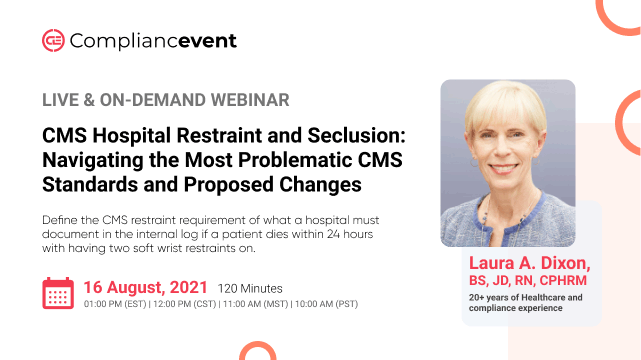- Topics
- Webinars
- Products & Services
Welcome To Biggest Online compliance Platform By LOCGFX Pvt. Ltd.
Healthcare
Recent changes made in restraints by CMS in November 2019 changed the term from LIP (licensed independent practitioner to LP (licensed practitioner). This allows hospitals to allow PAs to write orders for restraints in states where they were considered to be dependent practitioners.
The number one area of deficiencies in the CMS CoP is regarding restraints. CMS issued a memo summarizing all of the deficiencies against hospitals. This program will discuss the most problematic standards in the restraint section. There are 50 pages of the CMS interpretive guidelines related to restraints.
Some key issues with restraints from CMS and Joint Commission include a requirement that any physician or provider who orders restraint must be trained in the hospital’s policy; CMS and Joint Commission requirements for hospital staff to be educated on restraint and seclusion on an annual basis. CMS also says that restraint training must be ongoing so you cannot only provide training at orientation. CMS has ten pages of training requirements.
Restraint and Seclusion are a hot spot with both CMS and the Joint Commission and a common area where hospitals are cited for being out of compliance. CMS has issued interpretive guidelines on restraint and seclusions for hospitals.
Every hospital that accepts Medicare patients will have to comply with the interpretive guidelines even if the hospital is accredited by the Joint Commission, HFAP, CIHQ, or DNV Healthcare. Hospitals will need to make sure their policies and procedures comply with these. Joint Commission and CMS both require restraint training for staff.
There are basically 21 rules covered by the CMS interpretive guidelines. The Joint Commission standards on restraint and seclusion will be the reference and are now closer in the crosswalk. Patient safety is at risk and patients have been injured or died from improper restraint usage.
-Define the CMS restraint requirement of what a hospital must document in the internal log if a patient dies within 24 hours with having two soft wrist restraints on.
-Recall that CMS requires that all physicians and others who order restraints must be educated on the hospital policy.
-Describe that CMS has restraint education requirements for staff.
-Discuss that CMS has specific things that need to be documented in the medical record for the one-hour face-to-face evaluation on patients who are violent and or self-destructive.
-Right to be free from restraint
-Number of deficiencies
-Providing copy of rights to patients
-Restraint protocols
-CMS changes effectively to internal log and soft wrist restraints
-Most current manual
-Medical restraints
-Behavioral health restraints
-Violent and self-destructive behavior
-Definition of restraint and seclusion
-Leadership responsibilities
-Culture of safety
-Drugs used as a restraint
-Standard treatment
-Learning from each other
-Restraints does not include
-Side rails, forensic restraints, freedom splints, immobilizers
-Assessment
-Order for restraint
-Documentation requirements
-Least restrictive requirements
-Alternatives
-RNs and One-hour face to face assessment
-New training requirements
-New death reporting requirements
-PI requirements
-Time-limited orders and renewing orders
-Staff education
-Stricter state laws
-Monitoring of patient in R/S
-Joint Commission Hospital Restraint standards and differences from CMS
-All nurses with direct patient care
-Compliance officer
-Chief nursing officer
-Chief of medical staff
-COO
-Nurse Educator
-ED nurses
-ED physicians
-Medical staff coordinator
-Risk manager
-Patient safety officer
-Senior leadership
-Hospital legal counsel
-PI director
-Joint Commission coordinator
-Nurse managers
-Quality director
-Security guards
-Accreditation and regulation staff and others responsible for compliance with hospital regulations
-Anyone involved in the restraint or seclusion of patients
-Persons responsible for rewriting the hospital policies and medical staff bylaws
-Staff that remove and apply restraints as part of care – such as radiology techs, ultrasound technologists, transport staff, and others.

Laura A. Dixon served as the Director, Facility Patient Safety and Risk Management and Operations for COPIC from 2014 to 2020. In her role, Ms. Dixon provided patient safety and risk management consultation and training to facilities, practitioners, and staff in multiple states. Such services included the creation of and presentations on risk management topics, assessment of healthcare facilities; and development of programs and compilation of reference materials that complement physician-oriented products.
Ms. Dixon has more than twenty years of clinical experience in acute care facilities, including critical care, coronary care, peri-operative services, and pain management. Prior to joining COPIC, she served as the Director, Western Region, Patient Safety and Risk Management for The Doctors Company, Napa, California. In this capacity, she provided patient safety and risk management consultation to the physicians and staff for the western United States.
Ms. Dixon’s legal experience includes medical malpractice defense and representation of nurses before the Colorado Board of Nursing.
As a registered nurse and attorney, Laura holds a Bachelor of Science degree from Regis University, RECEP of Denver, a Doctor of Jurisprudence degree from Drake University College of Law, Des Moines, Iowa, and a Registered Nurse Diploma from Saint Luke’s School Professional Nursing, Cedar Rapids, Iowa. She is licensed to practice law in Colorado and California.
Compliancevent Webinar Certification - Compliancevent rewards you with Compliancevent Achievement Certification for unlocking and attending this webinar. It is to acknowledge your participation in this training session and to add more to your professional score.
Compliancevent Courses and Webinars or any Education published "Articles & Materials" strictly follows the standards and guidelines of the Professional Credit / CEU Providers and Well Researched before publishment.
Compliancevent doesn't support any Fake - News, Articles, or Compliance updates; Our Industry Experts are highly verified and recognized, and their Pre-publishment is verified via our experts and fact-checkers.
Sign up now on compliancevent.net. Visit compliancevent.net/webinar to discover a wide range of webinars from industry specialists. Tick on either ‘live webinar’ or ‘on-demand’, and simply click on ‘buy now’ to get enrolled.
You can refer compliancevent to anyone in your social circle. Explore your industry with your colleagues by getting them signed up on compliancevent.net today!
Go for the topic of your keen interest on compliancevent.net. Tick on ‘live webinar’ and get enrolled! Easy registration, transparent transaction.
You can request for an on-demand webinar that records the live webinar for you. After the webinar ends, you will have full access to the webinar’s recording. You can also explore compliancevent offline to order your webinar DVDs, flash drives and transcripts.
If you can’t attend the live webinar, simply go for the ‘on-demand webinar’ for the same price! Now, the live webinar recording will be saved in a cloud storage for you to access anytime from anywhere.
compliancevent offers both hard and soft copies of the webinars. It contains all the highlights as well as comprehensive descriptions of the webinar, so you never miss out a single detail.
After attending the live webinar, your certificate will be emailed to you. You can download it and add more charm to your professional score.
At the end of each webinar, you have the opportunity to interact with your industry experts, where you will get answers to all your queries.
Can’t attend the live webinar? compliancevent has got you covered! You can always switch to the on-demand webinar from your portal. You can also get your hands on the webinar’s DVD/flash drive and transcript. So order them now!
compliancevent brings a variety of options for offline learning. Order your DVDs, flash drives or transcripts now to have a lifetime access to compliancevent webinars. You can also go for on-demand recordings. Download and watch it anytime from anywhere in the world!
